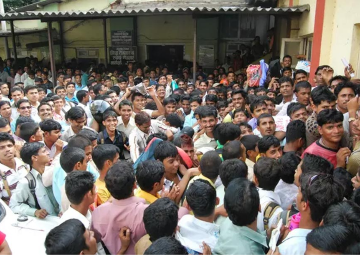
Governments are the biggest spenders in national economies. As per the
IFPRI SPEED 2019 database, global expenditure in agriculture, communications, education, defense, health, mining, social protection, fuel and energy, and transport for 110 countries in 2015 is estimated at US $19.3 trillion in current terms or 26 percent of global GDP.
By 2022, the average spend would be higher as even advanced economies are running fiscal deficits in the high single digits. Credit markets let them pile up debt to finance their expenditure, secure in the belief that these economies have enough fiscal resilience to pay back the excess debt. The problem is, profligate public spending is habit-forming and it is hard for vote-seeking governments to pull back from a loose money policy. Even modern autocrats tend to dilute opposition by stuffing protesting mouths with cash and are, thereby, prone to overspend.
The big spenders
In 2015, one half of the global government expenditure was by just four countries, each with an annual spend above US$1 trillion (the Unicorn governments)– United States, China, Germany, and France. Another 24 percent was on account of just six countries (the Big Six) – United Kingdom, Italy, Brazil, Japan, Russia, and Spain, each with expenditure between US$ 500 billion to 1 trillion. Fifteen others – all with expenditures between US$100 to 350 billion—including Netherlands, India, and Saudi Arabia, which accounted for 18 percent of the total expenditure.
Credit markets let them pile up debt to finance their expenditure, secure in the belief that these economies have enough fiscal resilience to pay back the excess debt.
The remaining 82 countries, each with an annual spend below US$ 100 billion, accounted for just 7 percent of the total spend. This disparity, with public spending power concentrated in the top 25 countries, explains the closed-door nature of select clubs for non-formal, international consensus and decision making like the G7, active across geopolitics, trade, finance, and security since 1973; or the G20, a recent 1999 creation, to diversify the composition of the club in a nod to the dispersion of global spending power.
Starting in the late 1980s, New Public Management sought to integrate smart business practices into slow coach public governance systems. One of the key innovations was to define service delivery chains better and fix performance targets to each link, starting from inputs to outputs and ending with outcomes, to monitor performance closely.
Ingredients of the public service delivery chain
Inputs are the building blocks which go into delivering an output. For instance, to impart education to children, inputs will include qualified teachers being paid on time, procuring and having the relevant teaching aids and equipment, and a clean, safe, and sanitary place to teach the children. Regular attendance by teachers and children and full coverage of the curriculum could be measurable outputs. Outcomes are higher level results or proxies for measuring the achievement of project objectives, like the ratio of students passing the annual examinations and how well they do. Ensuring that school graduates are imbued with communication and life skills, civility, morality, social empathy, and the zeal for innovation are higher level outcomes, difficult to measure immediately but trackable through selective tracer studies.
To impart education to children, inputs will include qualified teachers being paid on time, procuring and having the relevant teaching aids and equipment, and a clean, safe, and sanitary place to teach the children.
Not so hot on outcomes, as on inputs and outputs
Sadly, governments have yet to internalise the need to focus on outcomes, even more so than on outputs. That we pay insufficient attention to outcomes, is evident from our budgetary process where the emphasis is on the supply side of “inputs”, ie, cash, personnel, furniture, construction, and equipment and related outputs but negligibly on the outcomes.
Tracking broad based growth
Economic growth is the sole, high-level outcome, which is diligently monitored globally and pursued. But it is the outcome of millions of economic agents incentivised through a contextual rewards system, which enhances efficiency, innovation, network-based solutions, and continuing skill upgradation. The dispersed nature of growth drivers makes monitoring and collation of results difficult. The default option to timely data-based analysis of growth lags, is to throw more money at the perceived problem. Delivery chain analysis red flags areas of inefficient or ineffective allocations and spending.
Consider that poorly educated children are more likely to be drags on productivity enhancement rather than growth drivers. High morbidity, particularly in mothers and children, is not only economically wasteful, but it also robs future generations of the impetus of sustainable growth.
Shun “K” shaped growth
The “K” shaped, post covid pandemic growth pattern is the outcome of insufficient attention being paid to broadening of the drivers of growth. Incremental income must be fairly distributed across the income percentiles through targeted job creation, “tax and distribute” strategies, or productivity enhancements. Focusing on aggregate economic growth is like an investor tracking the headline changes in the NIFTY (a National Stock Exchange index) but ignoring the fluctuations in her own portfolio of stocks—the latter are the most closely related to her welfare and, hence, far more significant.
High morbidity, particularly in mothers and children, is not only economically wasteful, but it also robs future generations of the impetus of sustainable growth.
High levels of income inequality are detrimental to social cohesion and sustainable growth. Economies where income differentials are low have far greater individual, familial and community resilience built into them than economies where the “K”-shaped growth pattern systematically diminishes family reserves at the bottom whilst grossly enlarging those at the top.
Outcome budgeting in India—an underutilised tool
India has tabled outcomes budget since fiscal 2006-07. But it remains a work in progress—an add on to the core budget documents—rather than the key instrument for rationalising proposed outlays. The Finance Minister’s budget speech underuses the explanatory power of an outcomes budget to rationalise why outlays should be increased or decreased, supported by surveys, estimating the efficacy of public spending in achieving outcomes. The reason is clear. The metrics used in the outcomes budget do not define hard, logically connected inputs, outputs, and outcomes. They offer little guidance for budgetary or programmatic adjustments to enhance the effectiveness of spending.
Hungry Kya?
Consider that India was quick to
protest against The Global Hunger Index 2022 (GHI) recently released by Concern Worldwide and Welt Hunger Hilfe, Non-Government Organisations from Ireland and Germany, which ranked India at 107 among 121 countries. This was down from rank 99 in 2014. More importantly, the index worsened the aggregate score (a lower score is better) by 3.3 percent from 28.2 in 2014 to 29.1 in 2021.
Of the four metrics, India improved its score in two—child stunting improved by 15 percent and infant mortality by 26 percent over 2014. But the metric for undernourished population worsened by over 10 percent and that for child wasting by 28 percent.
The four performance metrics are a joint responsibility of at least three ministries—Ministry of Consumer Affairs, Food and Public Distribution (MCAFPD), which distributes free or subsidised cereal; Ministry of Health and Family Welfare (MOHFW) for infant mortality; and the Ministry for Child and Women Development (MCWD), which implements nutrition programs. The MOHFW was in the clear with a steady improvement in the infant mortality score from 12.6 in 1990 down to a satisfactory 3.3 in 2022.
The global war is now against “Hidden Hunger”, the consequence of inadequate intake of micronutrients and the deficiency of vitamins.
The MCWD fronted the assault, questioning the GHI methodology for measuring undernourishment via a survey of 3000 respondents as too small for India’s size. It did not, however, object to the instrument used – getting feedback from people likely to be undernourished. Curiously, MCAFPD never thought it necessary to monitor outcomes through feedback surveys even for a INR 2 trillion food security program equalling 5 percent of total budgeted expenditure. Its outcomes metric (FY 2022-23) is just an input. It stops at supplying food to the wholesale distribution channels.
No one, it seems, was responsible for monitoring that the supply of food also stopped people from sleeping hungry—the desired outcome. Blame a loosely designed Outcomes Budget.
On the metrics of child wasting and stunting, the MCWD reasons that these are inappropriate metrics for tracking hunger. But its own outcome budget for “Mission Saksham Anganwadi and Poshan 2.0”, a nutrition program, adopts the same metrics. A full belly does not necessarily end hunger. Dietary diversification is a key ingredient of nutrition. The global war is now against “Hidden Hunger”, the consequence of inadequate intake of micronutrients and the deficiency of vitamins.
The problem with the outcome budget of MCWD is that the specified outputs are wrongly defined as the creation of Anganwadi Centres equipped with drinking water, toilets, a garden and so on. None of these are outputs. At best, these are inputs for achieving outputs. Outputs could be the number of families which switch to a diversified diet or vitamin infused nutritious food, which sadly are missing. It is no surprise then that achieving the poorly defined outputs do not help in achieving the desired outcomes of reducing the number of wasted and underweight children.
An Outcomes Budget is a tool to improve expenditure outcomes. Well specified and relevant performance metrics can red-flag inefficiencies and provide clues for program restructuring. India might not be as hungry as The Global Hunger Index 2022 assesses. But it has served to highlight why and how budget allocations are being rendered ineffective. Citizens deserve better results. Let us win the test match, not argue with the umpire.
The views expressed above belong to the author(s). ORF research and analyses now available on Telegram! Click here to access our curated content — blogs, longforms and interviews.



 Governments are the biggest spenders in national economies. As per the
Governments are the biggest spenders in national economies. As per the  PREV
PREV


